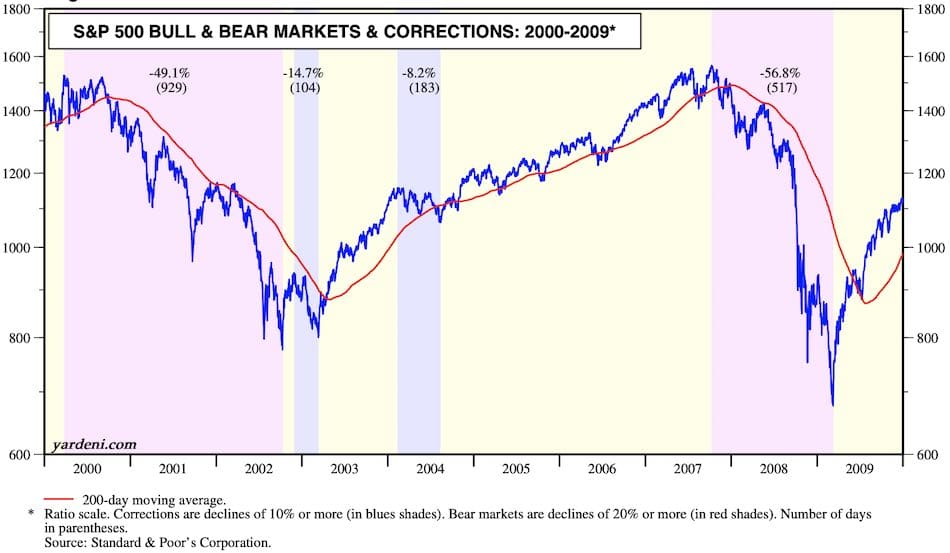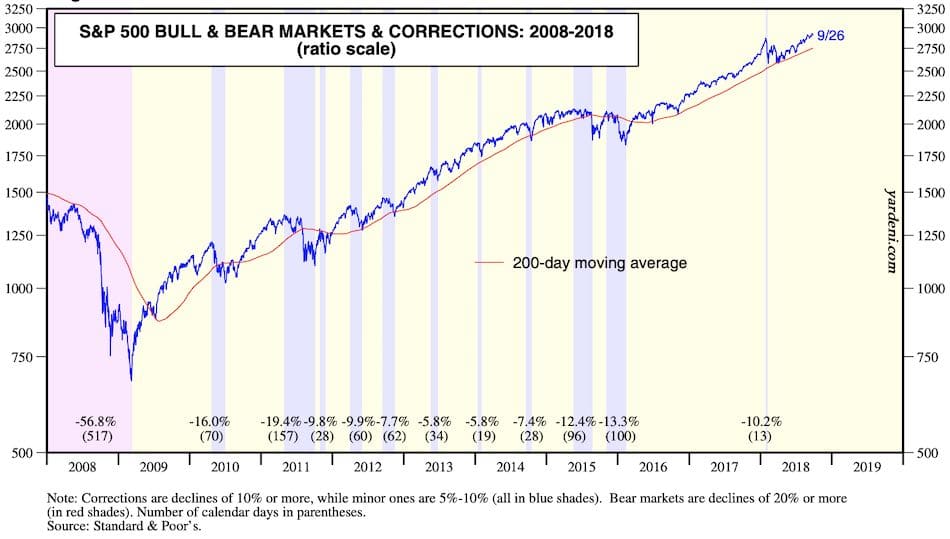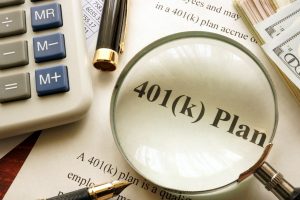Corrections in the stock market are unavoidable events that are part of being an investor in publicly-traded securities. Depending on your mindset, they can either be time of anxiety or great opportunity. Unfortunately, most people often do irreparable damage to their portfolio and investment returns by making poor decisions.
Quick Answers
There are several courses of action you could follow during a market correction. Following is a list of four options that are unlikely to result in you hating yourself a few years down the road. This list has served me well as an investor.
- Don’t Listen to the Media – The talking heads don’t know which way the market is going any more than you do. The only thing predictable in the markets is volatility. If you insist on watching the financial networks, realize what they are; great entertainment.
- Do Absolutely Nothing – To date there hasn’t been a correction in the U.S. stock market that wasn’t temporary. To quote Warren Buffet – “The trick is, when there is nothing to do, do nothing.” As simple as this advice sounds, it’s often the most difficult for people to follow.
- Do Not Sell Because the Market is Correcting – As you’ll learn later in this article, corrections don’t last nearly as long as most people believe. Selling at the bottom, locks in your losses which seriously hurt your long-term investment returns. So, unless you really, really, really need the money at this time, don’t sell.
- Shop for Buying Opportunities – During a correction, the price of well-run businesses goes on sale. So, regardless of whether you buy individual stocks or index funds, a stock market correction often provides the opportunity to buy dollars for 75 cents.
It’s a short but effective list. But just in case you’d like a bit more information to support why these suggestions make sense, read on.
To date there hasn’t been a correction in the U.S. stock market that wasn’t temporary. To quote Warren Buffet - "The trick is, when there is nothing to do, do nothing."
Ron Henry Click to Tweet
A History of Corrections
What most people are quick to label as a “stock market crash” is really better described as a correction. A correction is a 10% decline in price from a recent high. The term is most commonly applied to financial instruments like stocks, bonds, and index funds. The S&P 500 and Dow Jones Industrial average are usually what the financial networks are referring to when they discuss a correction.
A bear market is a more extreme form of a correction where the market declines 20% or more from a recent high.
It’s important to realize that stock market corrections happen with surprising regularity. Let’s look at the corrections we’ve faced between 2000 – 2018.
S&P 500 Market Corrections


The charts show that there have been 15 corrections in the years between 2000 and October 2018. Two of those 15 corrections resulted in the bear markets. (2000 – 2003 and late 2007 – early 2009)
15 corrections in 18 years means that on average a stock market investor can expect a correction approximately every 1.2 years. If we include the 929 days and the 517 days of the 2000 and 2008 bear markets, a correction has lasted an average of 152 days.
The bear market time periods are outliers which skew the average duration of a correction up by quite a bit. If we exclude the 2000 and 2008 bear markets we get an average correction duration of approximately 64 days. That’s just over 2 months – practically nothing given the 5 – 10-year horizon most long-term investors use to measure their results.
The reason for the quick history lesson is to highlight the fact that corrections happen all the time. Outside of the bear market events, they also don’t last for very long. Most of them are actually pretty difficult to see on the charts without close scrutiny. Quick quiz! Before looking at the above charts, could you recall the past three corrections? Most people can’t.
This lesson helps reinforce point number one – Do Nothing. If you’re not the type to buy when the market is down, simply sitting on your hands during a correction isn’t a bad thing. When you really think about it, doing nothing is doing something. History has proven that you won’t have to wait terribly long for the price of your securities to recover.
Don’t Listen to the Media for Investment Advice
The media can be a great source of interviews from seasoned investors like Buffett, Munger and Dalio. Outside of hearing from the world’s best long-term investors, I would take everything else you hear with a grain of salt.
The investment advice on television changes as often as the tides. If you hear something you don’t agree with, just wait an hour or two. Don’t take this as me bashing the media. I just want to stress the importance of thinking for yourself. It’s important to learn how to develop sound conclusions based on your own analysis.
Don’t take the shortcut of allowing others to form your opinions for you. I can assure that doing that will make for very expensive investing decisions and more excitement than you bargained for.
Selling During a Correction
Short of tax-loss harvesting, there’s usually no reason to sell securities because of a stock market correction. Given what you now know about their duration, selling your positions because of a correction makes little financial sense. Not being in control of the situation is what makes people reason that they “have to do something” and unfortunately, jumping ship is the option most take. Resist this urge.
It’s important to realize the fact that life is a repeating series of cycles. The tides, the path the earth takes around the sun and even our very existence. It’s a series of up and downs that we’ve grown to accept. Why then would you expect the securities markets to be any different?
When the market corrects, stocks, houses, and other investments go on sale. Do you walk into your local supermarket and say to yourself “Cripes! The price of bread has tanked. I’d better run home and sell mine quickly!” It sounds ridiculous because it is. The market will recover. The only variable is when. History shows that for the most part, it doesn’t take very long.
"Do you walk into your local supermarket and say to yourself “Cripes! The price of bread has tanked. I’d better run home and sell mine quickly!” It sounds ridiculous because it is. The market will recover."
Ron Henry Click to Tweet
Investing During a Market Correction
During a correction it’s likely that many of the securities you already own will be selling at a 10% discount or more. I like to call it a “sale” because the price of shares is less than when they were at their peak. It’s the same share of ownership – just discounted.
If you decide to take advantage of this temporary sale, where should you put your investible dollars? With the current prices in your portfolio already being down, pulling the trigger to buy more can be a tough emotional decision. Let me share my how I do it.
My Approach

Even before there’s a correction, I track my asset allocation using Personal Capital. Because my asset allocation is practically never 100% where I want it, there are always categories available for buying. At the beginning of each month, I update my list of index funds and stocks that I’d buy more of should they go on sale.
When buying opportunities like late 2015 or January 2018 present themselves, I load up. To quote Warren Buffett – “When it’s raining gold, reach for a bucket, not a thimble.” I use the money from my LPO (Large Purchases and Opportunities) bucket to fund these purchases. My three-bucket strategy for saving and investing is spelled out in detail here.
"When it's raining gold, reach for a bucket, not a thimble."
Warren Buffett Click to Tweet
Basically, I ensure that there’s always some cash available that’s earmarked for events like a stock market correction. The money I make by purchasing securities at a discounted rate more than offsets not being 100% invested.
Index Funds and Individual Stocks
What you’ll find during corrections is individual stocks tend to drop in price much more than index funds. It’s not uncommon for segments of industries that really have nothing to do with the correction get punished in a form of capitalistic collateral damage. Let’s use the October 2015 – February 2016 market correction as an example.
This correction was blamed on a combination of negative interest rates and an oversupply of oil. The condition incited a panic in the investment community which caused the masses to move out of equities of all sorts and into “safe” investments like gold and bonds. This is often a great time to increase your index fund positions. Assuming you’ve done the necessary research, you can also do very well with individual stocks.
The Case of ONEOK
I’d been keeping an eye on a midstream oil pipeline company called ONEOK (OKE) since the spring of 2015.
Midstream companies in the energy sector are involved in the transportation of oil or natural gas. These types of companies tend to have a relatively wide competitive moat due to the high barriers to entry. My analysis of the company showed that it was very profitable, well-run and had good prospects for future growth.
Once it became apparent that the market was trending down for no reason other than panic, I started buying in October 2015. I continued to do so through December 2015. ONEOK is an excellent example of a company whose stock was being punished during a correction for no reason other than the sector they were in.

I share this story to highlight that you can do very well as a long-term investor if you take advantage of the opportunities often afford by a market correction.
Preparing for the Next Correction
The single best advice I can offer to prepare for the next market correction has nothing to do with stocks, index funds or the volatility index. It has everything to do with improving your inner game. Your ability to execute your strategy during the next correction is largely based on how well you manage your psychology and emotions.
Even if your correction strategy is to do nothing, managing your psychology is still a big part of that. Getting this right is just as important as obtaining the proper investment education. What you learn about your personal psychological makeup will prevent you from becoming your own worst enemy.
Aim to gain a deep understanding of the cognitive biases that we all have to varying degrees. It will help you identify (and hopefully circumvent), the scenarios where you are most likely to do something silly.
"Successful investing in stocks and index funds requires that you focus on improving your inner game. Your ability to execute your strategy during the next correction is largely based on how well you manage your psychology and emotions."
Ron Henry Click to Tweet
Recommended Reading
If you only read one book on this subject, make it “What I Learned Losing A Million Dollars” by Jim Paul and Brendan Moynihan. If the title alone doesn’t say it all, I don’t know what does. Jim Paul tells the story of how he lost over 1 million dollars trading soybean oil due to errors in psychology. It’s important to note that he wasn’t an amateur by any stretch of the imagination. As a member of the Chicago Mercantile Exchange, he was a very experienced investor.
In the book he outlines all the ways his psychology concerning the markets negatively affected his judgement which resulted in risky trades. He makes the point that while there are countless ways to make money in the financial markets, there are only small number of ways to lose money. The book will help you build your personal list of cognitive biases you need to avoid. It vividly illustrates how badly things can get when you don’t keep your psychology in check.
My second book recommendation in this space is “Influence: The Psychology of Persuasion” by Robert B. Cialdini. It takes a deep dive into the major cognitive biases to uncover how people make decisions. Because successful investing is largely about good decision-making, this book is required reading.
After reading both books, I encourage you to create your personal list of cognitive biases. Ask yourself how you will identify when you’re allowing a given bias to influence your decision-making process. Take the time to know thyself.
Closing Thoughts
Hopefully you’re seeing that stock market corrections don’t have to be times of great panic. They happen more frequently than people realize and for the most part are gone before you know it. Focus on improving your psychology. If your choice is to increase your investing during the next downturn, begin assembling your stock and index fund shopping list.
You’ll do much better if you already have your strategy worked out ahead of time. All that will be left is the execution of your plan. When the next market correction hits, you’ll be in a much better position to ride it out with less heartburn. How does his article compare to your current investment plan? What did you do during the last stock market correction? Let me know in the comments below!
A great FREE tool I personally use for tracking my portfolio is Personal Capital. When you click this link to sign up for your free account, both you and I will receive $20. Every little bit helps right?
Full Disclosure: The links on both the Essential Reading and my Books Reviews pages contain my Amazon affiliate code. If you purchase a book using that link I get a few pennies. Doing so does not change the price of the book for you. In addition, at the time of writing this post, I own a position in ONEOK (OKE).
Legal Disclaimer: The information provided and accompanying material is for informational purposes only. It should not be considered legal or financial advice. You should consult with an attorney, CPA or other professional to determine what may be best for your individual needs.




